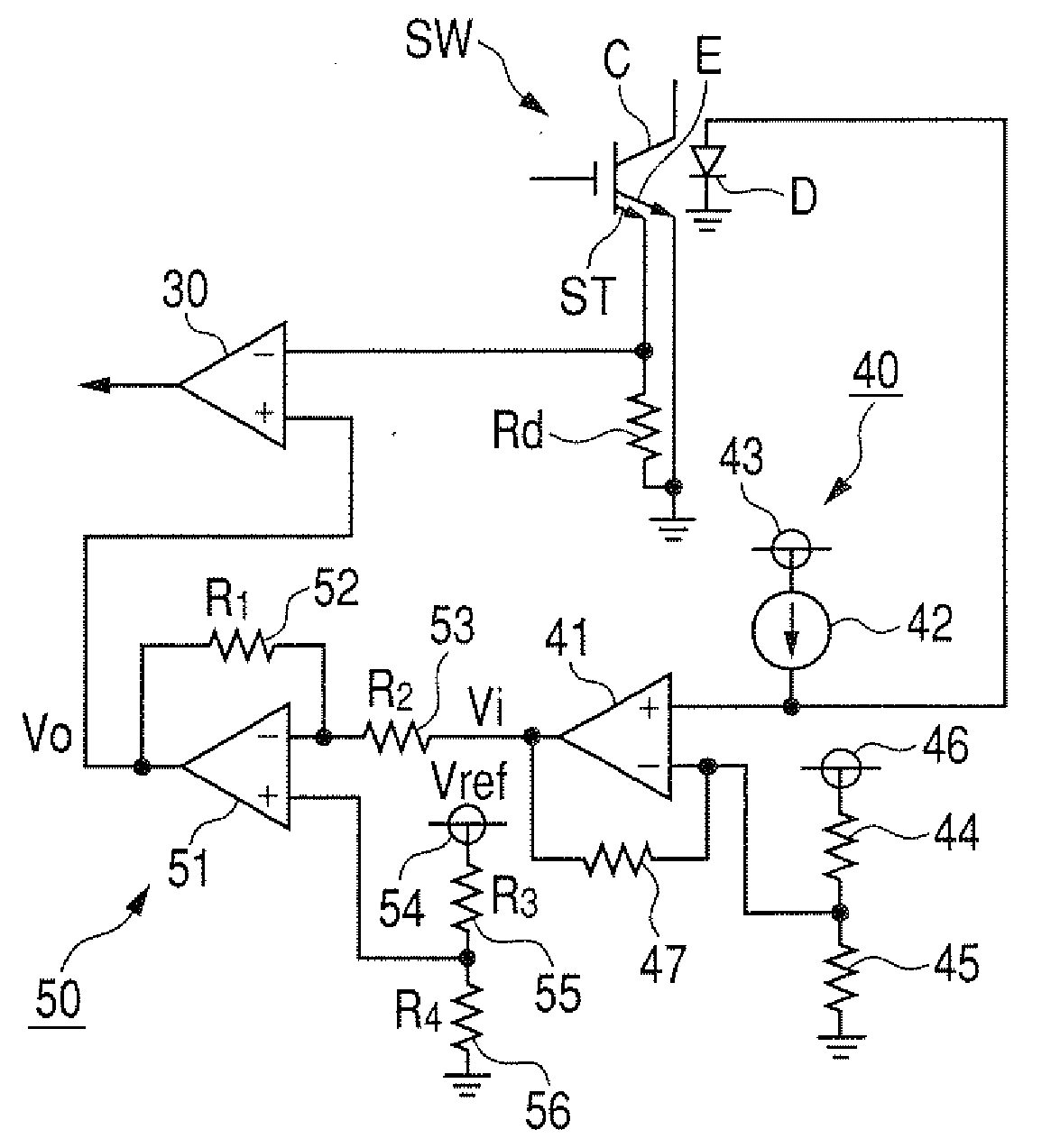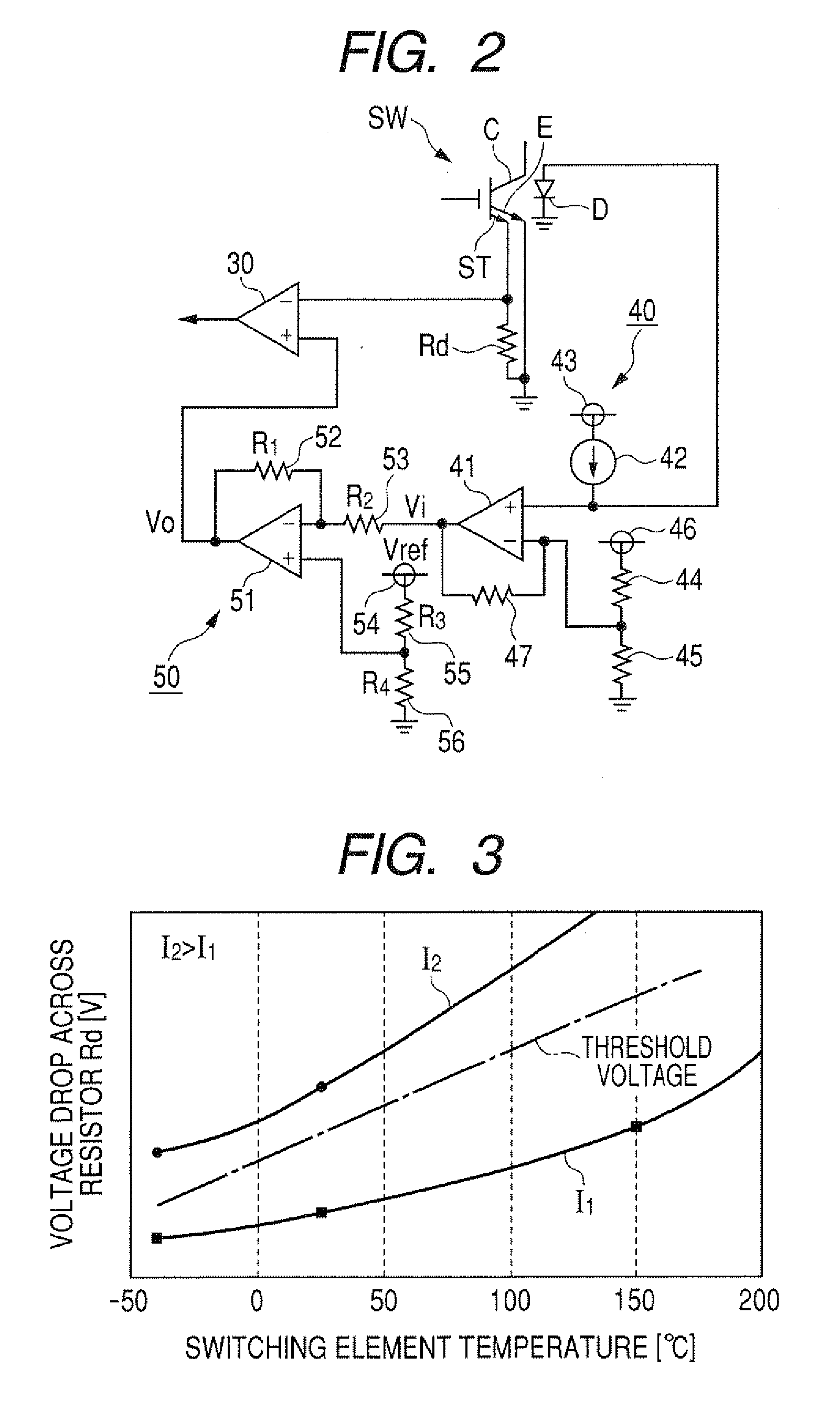Switching element overcurrent protection circuit which operates within a high-voltage system that incorporates the switching element
a protection circuit and switching element technology, applied in the direction of electronic switching, pulse technique, electrical apparatus, etc., can solve the problems of large overall circuit scale, and further delay in calculating the compensated threshold value by the microcomputer, and achieve accurate circuit configuration and simple circuit configuration
- Summary
- Abstract
- Description
- Claims
- Application Information
AI Technical Summary
Benefits of technology
Problems solved by technology
Method used
Image
Examples
second embodiment
[0093]A second embodiment of an overcurrent detection circuit will be described in the following referring to the circuit diagram of FIG. 5, with the description being centered on the points of difference from the first embodiment. In FIG. 5, components corresponding to components in the first embodiment are designated by corresponding reference numerals to those of the first embodiment.
[0094]This embodiment incorporates an output conversion circuit 60, which performs conversion of the temperature detection signal Vi in place of the output conversion circuit 50 of the first embodiment. With the first embodiment, the output conversion circuit 50 converts an approximately linear temperature variation characteristic of a diode to a corresponding approximately linear temperature variation characteristic having an inverted slope direction (e.g., as shown for the threshold voltage in FIG. 3), with the slope and DC voltage offset amount of that characteristic being adjusted appropriately. ...
third embodiment
[0110]A third embodiment of will be described in the following referring to the circuit diagram of FIG. 6, with the description being centered on the points of difference from the first embodiment. In FIG. 6, components corresponding to components shown in FIG. 1 are designated by corresponding reference numerals to those of FIG. 1.
[0111]With this embodiment as shown in FIG. 6, in each upper stage and each lower stage of each phase leg of the inverter 12, a pair of switching elements are connected in parallel. For example the switching elements SW1a, SW1b are connected in parallel in the upper stage of the U-phase leg, while the switching elements SW2a, SW2b are connected in parallel in the lower stage of that phase leg. This is done in order to enable the level of current that flows in each phase of the inverter 12 to be increased, while ensuring that the current that flows in each switching element is maintained within design specifications. With such a configuration, the switchin...
fourth embodiment
[0120]A fourth embodiment will be described in the following referring to the circuit diagram of FIG. 8, which shows an overcurrent detection circuit that is representative of each of respective overcurrent detection circuits incorporated in the protection circuits PC1 to PC6 of this embodiment, with the description being centered on the points of difference from the third embodiment described above. In FIG. 8S, components corresponding to components shown in FIG. 7 are designated by corresponding reference numerals to those of FIG. 7.
[0121]With this embodiment, the respective temperature detection signals Vi(a), Vi(b) outputted from the gain adjustment amplifiers 40a, 40b are applied through resistors 72a, 72b which are of identical value, to the inverting input terminal of the operational amplifier 51. As a results, an averaging circuit is constituted by the combination of the resistors 72a, 72b and the operational amplifier 51, whereby the output conversion circuit 50 sets the le...
PUM
 Login to View More
Login to View More Abstract
Description
Claims
Application Information
 Login to View More
Login to View More - R&D
- Intellectual Property
- Life Sciences
- Materials
- Tech Scout
- Unparalleled Data Quality
- Higher Quality Content
- 60% Fewer Hallucinations
Browse by: Latest US Patents, China's latest patents, Technical Efficacy Thesaurus, Application Domain, Technology Topic, Popular Technical Reports.
© 2025 PatSnap. All rights reserved.Legal|Privacy policy|Modern Slavery Act Transparency Statement|Sitemap|About US| Contact US: help@patsnap.com



